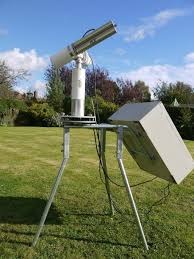Instrument Support Level 3
Cimel, CE318
ncas-sunphotometer-2
aerosol-optical-depth
£35,000
128.5 cm x 150 cm x 101 cm. 10kg
See page for details
£20
Calendar

Cimel Sun Photometer
The Cimel CE318 Sunphotometer is a multi-channel, automatic sun-and-sky scanning radiometer that measures the direct solar irradiance and sky radiance at the Earth’s surface.
Measurements are taken at pre-determined discrete wavelengths in the visible and near-IR parts of the spectrum to determine atmospheric transmission and scattering properties. This instrument is weather-proof and requires little maintenance during periods of adverse weather conditions. It takes measurements only during daylight hours (sun above the horizon).
This high-precision multiband photometer measures the optical properties of the atmosphere especially by measuring, on one hand, the solar irradiance and on the other hand the soil and sky radiance. It provides the quantification and physical-optical characterizations of the aerosols. Due to its very low power consumption thanks to the MicroAmps® technology, to its self-powered system and to its rugged design, the CE318 fully meets the operational requirements of continuous monitoring in terms of reliability, long lifetime and very low maintenance cost.
The CE318 photometer technology is constantly enhanced to match the new technological challenges for climate observation and monitoring. Cimel’s photometers are still the benchmark devices for most aerosol observing networks and more specifically for the international federation of AERONET.
The large range of parameters that are derived and calculated from the measurements and from the atmospheric physics equations make the CE318 photometer a worldwide benchmark device. for the following applications:
- Characterization and quantification of aerosols
- Satellite calibration of aerosol measurements
- Detection of volcanic ashes plumes in real-time
- Determination of Aerosol Optical Depth (AOD)
- Determination of fine mode and coarse mode AODs
- Determination of the optical properties of the atmosphere for satellite imaging
- Determination of the ocean’s colour
- Determination of the amount of precipitable water vapour
- Air quality monitoring
- Volume size distribution
- Nature of aerosols
A sun photometer is an electronic device that measures direct sunlight over a narrow range of wavelengths.
When a sun-photometer is placed somewhere within the earth’s atmosphere, the measured radiance is not equal to the radiance emitted by the sun (i.e. the solar extraterrestrial radiance), because the solar flux is reduced by atmospheric absorption and scattering. Therefore, the measured radiant flux is due to a combination of what is emitted by the sun and the effect of the atmosphere; the link between these quantities is given by Beer’s law.
The atmospheric effect can be removed with Langley extrapolation; this method, therefore, allows measuring the solar extraterrestrial radiance with ground-based measurements. Once the extraterrestrial radiance is known, one can use the sun photometer for studying the atmosphere, and in particular for determining the atmospheric optical depth. Also, if the signal at two or more suitably selected spectral intervals is measured, one can use the information derived for calculating the vertically integrated concentration of selected atmospheric gases, such as water vapour, ozone, etc.
The unit is calibrated annually.
Minimal servicing is required.
Costs
- Instrument Insurance
- This system must be insured by the user for £30K and covers loss, theft or damage to the instrument: damage is that over and above general wear and tear. The system has been designed to be rugged and autonomous. Even so, the end-user must respect the fact that the system is a precision optical instrument that must be treated with great care.
- The user is responsible for the instrument from the time it leaves the AMF to the time it is returned and signed off as in an acceptable operating condition by the IS: this will be done as soon as is possible on its return.
- Public Liability Insurance
- The AMOF is not liable for any damage or injury arising from the deployment or operation of this instrument when unattended by the IS.
- Shipping Expenses
- The user is liable for all costs arising from the shipping of the instrument both to and from a deployment.
- IS T&S
- The user is responsible for coving the travel and subsistence expenses of the IS while attending the instrument.
Shipping
The system when packed ready for shipping consists of a six box of various size and weight
Please contact the facility for more details
The system is self-contained and requires no power or network connection to operate.
The photometer will require an unobstructed sight of the sun and moon – the site should be clear of obstructions on the east-west transect at all angles.
Manual handling
- A procedure appropriate to lifting a heavy object should be used when installing. This procedure consists of bending at the knees while keeping your back straight and upright.
Electric safety
- Check all components are in good condition before switching on.
Attended operation
- There is no requirement for the system to be attended during operation from a safety standpoint.
COSHH
- Not applicable
Temperature range
- -20°C to 50°C (in non-icing conditions)
Humidity range
- 0 to 100% RH (in non-icing conditions)
Field Data
- The instrument produces a range of out files and all are text format.
- The user can download (but not delete) this data from the instrument but it should be noted that this data will not have been quality controlled.
Archive Data
- Data is provided in NetCDF files following the AMOF data standard
- Files contain no more than 24hr of data.
- Instrument name is
- ncas-sunphotometer-2
- The data product(s) associated with this instrument:
- Example data file
